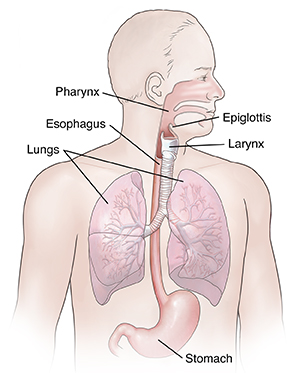Larynx-Lifting Exercises for Dysphagia
Larynx-lifting exercises can help you swallow better. You may need these exercises if you have trouble swallowing (dysphagia). Your larynx is the part of your throat that is also known as your voice box. The exercises can improve the strength, mobility, and control of muscles in the larynx. Over time they may help you to swallow normally again. These exercises are sometimes used with other types of swallowing exercises. A speech-language pathologist (SLP) will tell you what exercises to do.
How swallowing works
Before you swallow, you chew your food to a size, shape, and texture that can be swallowed. This is called the first phase of swallowing. When you swallow, this material passes through your mouth and down through parts of your throat called the pharynx and larynx. From here the food goes down through a long tube (esophagus). It then enters your stomach. This movement needs a series of actions from the muscles in these areas.
When you breathe, air passes through your pharynx and larynx, too. It then travels down through a long tube called the trachea before it reaches your lungs. There is a small flap of tissue called the epiglottis that covers your larynx when you swallow food or liquid. This is so food and liquid don’t go into your trachea and lungs. Muscle weakness in any of these areas can make swallowing difficult.

When larynx-lifting exercises are needed
You might need to use larynx-lifting exercises if you have dysphagia. Dysphagia can lead to food or fluid going into the airways and lungs (aspiration). This can lead to pneumonia and other problems. Because of this, it’s important to treat your dysphagia right away. In normal swallowing, the larynx moves up and out of the way of the food or liquid so it can pass safely into the esophagus. An SLP will prescribe larynx-lifting exercises if you are having trouble with your second phase of swallowing (the movement of food going down your throat).
Many conditions can lead to trouble swallowing, such as:
-
Stroke
-
Severe dental problems
-
Mouth sores
-
Conditions that reduce saliva, such as Sjogren syndrome
-
Parkinson disease or other neurologic conditions
-
Muscular dystrophy
-
Blockage in the throat or esophagus, such as a tumor or a stenosis (narrowing)
-
History of radiation therapy or surgery for throat cancer
When you have a problem with the second phase of swallowing, you may need to work the muscles in your throat. Larynx-lifting exercises can help you keep your food moving down through the pharynx and into the esophagus.
Risks of larynx-lifting exercises
Larynx-lifting exercises are very safe. If you have any mild pain, you can stop doing them. Let your SLP know right away if you experience pain or discomfort.
Getting ready for your exercises
Before you start these exercises, you may need to change your positioning. Your SLP will show you how to do so, if needed. For example, it may be better if you do these exercises while out of bed.
It's best to remove distractions from your environment. Turn off the TV. Do the exercises at a time when you won’t have visitors. You will be able to fully focus and get the most benefit from them. You can do these exercises at any time that is good for you. Your SLP will let you know if there is anything else you need to do before getting started.
Sample exercises
You may do the exercises in your hospital room or at home. Often you can do them on your own. They may be used with other types of exercises to help you swallow better.
Your SLP can show you the exercises you will need to do and tell you how often to do them. You may need to do them several times a day. For example, you may be asked to do these:
-
Mendelsohn maneuver. Start to swallow. Use your throat muscles to stop your Adam’s apple at its highest point for a couple of seconds. At first, it may help you to use fingers to help keep it up. Then finish the swallow. Allow your Adam’s apple to return to a resting position.
-
Falsetto exercise. Use your voice to slide up the pitch scale as high as you can, to a high, squeaky voice. Hold the high note for several seconds with as much strength as possible. While you do this, you can gently pull up on your Adam’s apple.
Both of these exercises help lift the larynx, which may improve your swallowing.
You will likely be doing larynx-lifting exercises along with other types of swallowing exercises. If so, write down the exercises and do them in the same order each time. This will help make sure you don’t forget any exercises.
Keeping track of your progress
Keep a record of the times you do your swallowing exercises. It will remind you to do your exercises as prescribed. It will also give helpful feedback on your progress to your SLP. Write down what exercises you did and when you did them. Also write down any problems you had. Discuss them with your SLP.
As your ability to swallow improves, your risk of aspiration may lessen. Your SLP may be able to change your diet. You may also be able to eat certain types of food again. This can improve your nutrition, your overall health, and your quality of life.
You may still have problems with swallowing even after practicing these exercises often. Your SLP will tell you what kind of progress to expect.
Continue to practice all of your swallowing exercises as prescribed by your SLP. You will benefit most from following the therapy exactly as prescribed. Your progress may be less if you skip practice sessions. Work closely with all the members of your healthcare team. This will help increase your chance of a good outcome.